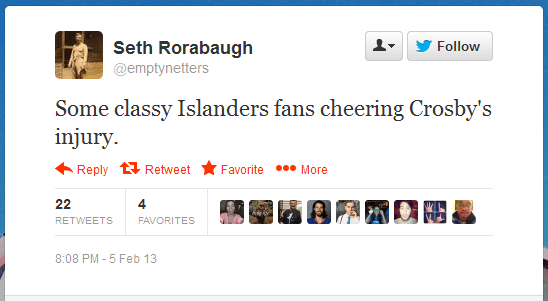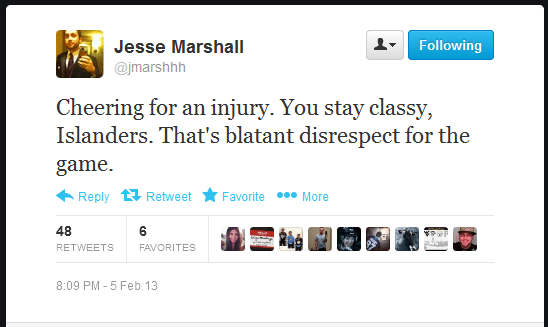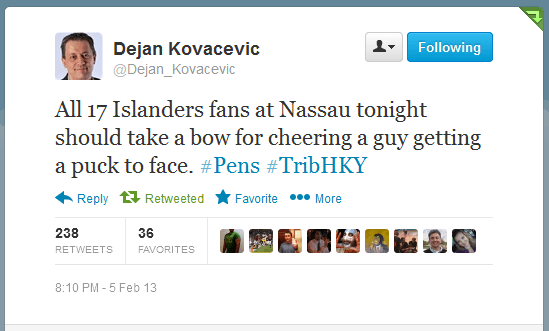Pittsburgh and the Mystical Winger: A Penguins Tale of Lore
April 2, 2013 3 Comments
Do you like bad fan fiction? Do you like hockey?
If you answered “yes” to both of those questions, this post is for you!
There is a fairy tale that has been told in Pittsburgh for some time now.
It is a chronicle about one man in search of eternal glory – not only for himself, but for his people and his small, but loyal army. His name was Ray Shero and he dreamt of drinking from a hallowed cup, the most precious of trophies and the most coveted of possessions among his peers. And he wanted to drink from this great Cup more than once, for he was a great wizard, deserving of great riches and heavenly wealth.
But to achieve this, some thought, Shero would have to find a man first. Prophecy foretold that this man would one day arrive in Pittsburgh, through no easy means, and find great comfort and success on the wing of Sidney Crosby, the vaunted White Knight.
But to speak of Shero’s vaunted White Winger, one must first understand Crosby.
Crosby was no commoner, himself. He had already fulfilled a prophecy, one which named him “The Next One.” At the age of 18 and in his first NHL season, he had already salvaged a dying Penguins franchise and a wilting National Hockey League. He did this with the help of a great 66, called “Le Magnifique” by some and Mario Lemieux by all.
But even though Lemieux and Crosby brought the NHL back into the public’s favor after a devastating lockout in 2004-2005 and saved the Penguins franchise from bankruptcy and relocation, there was still work to be done.
For you see, the Penguins still existed, but only barely. Even with Crosby finishing sixth in league scoring with 102 points (39 goals, 63 assists) and a runner-up bid for rookie of the year, the Penguins still finished second from last in the NHL with 58 points. Even Lemieux couldn’t help his ill-gotten team, for he had grown old by then and could no longer carry the remaining weight of the franchise on his shoulders.
The team’s mediocrity didn’t last, though. The very next season, they finished second in the Atlantic Division with an astounding 105 points. Crosby had grown into the vision the hockey gods had projected. He led the NHL with 120 points (36 goals, 84 assists) and won the Hart Trophy, becoming the youngest player and only teenager to win a scoring title. Crosby was also named the league MVP and received the Lester B. Pearson Award as the most outstanding player, becoming the seventh player in NHL history to earn all three awards in one year.
In 2008, Shero found himself pulling strings at the trade deadline. His army wasn’t quite legendary, but it was something to behold. It was the best in the East. Sidney Crosby, Evgeni Malkin, Jordan Staal, Kris Letang and Marc-Andre Fleury were all as formidable as anyone in the league and no one doubted the team’s greatness. But it seemed that they lacked a key piece to make them the best in all of hockey.
And that piece existed.
He was skating and shooting and scoring in the land of Atlanta, a land long forgotten by the hockey gods. It, perhaps, was shunned because of one evil winger that played there. Unfortunately, for Shero, he was the thought to be that piece. He was Marian Hossa, who later became known as the Dark Winger.
“We must have him,” Shero thought. And so he worked his great magic and the Penguins sent Colby Armstrong, Erik Christensen, Angelo Esposito, and a first-round pick in the 2008 Entry Draft to the Atlanta Thrashers in exchange for the heralded Hossa, as well as Pascal Dupuis.
Hossa helped carry the mighty Guins to the finals that season. But victorious the team was not. For unbeknownst to the Penguins and Shero, Hossa was a wolf in sheep’s clothing. He was a shape shifting evil doer, hell-bent on personal success with no connection to the mortal world.
He was not a team player.
So the Penguins lost to the Detroit Red Wings in six games. Driven by only his greed for personal success, Hossa departed from the Land of Steel for the Hell of the Midwest – Detroit, in search of glory of the evil variety.
Without Hossa the following season, the Penguins repeated as Eastern Conference champions. They crossed into the darkness of Detroit once more, this time besting the Redwings in seven games to capture the Cup in a valiant effort that will live in lore forever.
They drank from Lord Stanley’s fabled Cup, but some say it was against the will of the hockey gods. You see, although Detroit may be an evil land, it had become the home of the hockey gods, thus earning the city the name “Hockey Town.” The gods had built their sanctuary in the midst of the downtrodden city around them and that sanctuary was known as “the Joe.” It was the Joe Louis Arena, the oldest arena in the NHL. And because the Penguins seized the Stanley Cup on Game 7 in the Joe, snatching it away from the sanctuary of the hockey gods, they were cursed, doomed to never reach the Finals again.
But legend had it that if the Penguins were to find the White Winger, one man pure and devoted to the game and its fans, a captain of his own domain so incorruptible that he could endure a terrible team for years and still remain up-beat; only then could the Penguins return to the Finals and hoist the Cup once more.
In the coming seasons, the Penguins were tremendous. But as remarkable as they were, the playoffs became their Achilles heel because of the hockey gods’ curse. Once 82 games of regular season had elapsed, the Penguins lapsed. And for the three years following the Cup victory, the Penguins were ousted in either the first or second round of the playoffs.
Great regular season success followed by despicable postseason defeat was a curse that Shero’s people had great trouble enduring.
At the start of the 2010-2011 season, the Penguins believed they could triumph despite the curse and the lack of the White Winger. The hockey gods feared they were right. So in the midst of Crosby’s greatest season ever, the gods sent a lightning bolt crashing from the heavens during the nationally televised Winter Classic. It struck Crosby in the form of a David Steckel hit to the head. It was a hit that sent shockwaves throughout Shero’s kingdom.
Some foretold he may never play again. He missed nearly two full seasons, but by power of magic and great strength, he became the man he once was.
From then on, the Penguins and its fans realized they indeed needed the White Winger to succeed. This had everyone going on “watch.”
First it was “Jagr watch.” That wasn’t to be. Jaromir Jagr, once a masterful winger for the Penguins in the days of the first and second Penguins Cups, succumbed to dark sorcery and chose evil over good. He signed with the Philadelphia Flyers in the summer of 2011.
The following summer, Crosby’s good friend Zach Parise became the next prospective winger for the Penguins. “Parise watch” was in full force and many Pittsburgh faithful believed the ex-Devil’s captain would bring his talent to the Penguins and vie for a Cup. But once again, the hockey gods vetoed the suspicions and cast him to the great north of Minnesota, where he collected a king’s ransom.
So the final White Winger watch brings us to modern times. Rumors were whispered across the hockey landscape that the Penguins were closer than ever to finding him. Truth be told, the Penguins signed a winger, a captain, who many thought would fulfill the prophecy. He was Brenden Morrow, a veteran captain of the Dallas Stars. He was a born leader and would be valued because of his insight into the game and his gritty style of play. He had long been a bastion of good will in a town where the hockey gods had not been kind to in quite some time. He was pure of heart and remained upbeat in an unsuccessful hockey town.
After quick consideration, the Penguins faithful decided he was close enough to the prophecy. He played the wing. He probably wouldn’t supplant the outstanding wingers Crosby already had (Dupuis and Chris Kunitz) but he would fill the second-line role that was needed badly.
The visions had changed scripture and it was no longer Sid’s winger, but the second line’s winger that would fulfill prophecy. Dreamers fell back down to earth and realists realized something great: This Penguins team was now built for a deep run in the playoffs.
After the addition of the mountain-of-a-man, troll defenseman Douglas Murray a day later, reality now became the prophecy. Shero had found his pieces. The missing rook and the absent bishop were now on the board and Pittsburgh was more than capable of a checkmate against any team in the league.
But there had been another winger in the land of hockey, one of great value. His name was Jarome Arthur-Leigh Adekunle Tig Junior Elvis Iginla. He hailed from the west of Canada for many years and donned a “C” on his chest and a “C” over his heart. Some soothsayers claimed that he was that mystical winger who could fill the void in Pittsburgh. This, of course, was before it was filled by Morrow, so it could no longer be.
But the days following the Morrow signing, these same oracles still whispered about Iginla’s interest in Pittsburgh. Most folk responded to these whispers with “delusions of grandeur! For Shero is done. He has finished his work, so let us be merry now without conjecture and speculation from fools with unnamed sources.”
The doubters were right. On a dark Wednesday night, as the newly acquired Penguins traveled toward their new kingdoms, the oracles confirmed that Iginla had indeed agreed to become a Boston Bruin. Penguins fans were not pleased, but certainly not worried. Although the Bruins would be their toughest playoff adversary, Iginla’s addition would certainly not guarantee a Pittsburgh demise.
“So be it,” they said. “Let Iginla skate for Beantown. It shall make no difference.”
So Penguins fans laid their heads to their pillows and began to dream new dreams. These were dreams of a tougher Penguins team, one that could score and skate and deliver blows to the opposition. They would have been nightmares had they been dreamt by fans of any other team.
But while they all slept, the great Shero was wide-eye and sharp minded in his quarters. His phone in hand and wit ablaze, he conspired in the early morning hours, working magic not seen in Pittsburgh since 1991, when another great wizard GM by the name of Craig Patrick clouded the minds of the Hartford Whalers management and usurped Ron Francis, Ulf Samuelsson and Grant Jennings in exchange for Jeff Parker, Zarley Zalapski, and John Cullen.
Shero had landed Iginla.
With a flick of his wand, Shero sent a 2013 Penguins first round draft choice and prospect forwards Kenneth Agostino and Ben Hanowski to Calgary in exchange for a future hall of fame right winger. Presumably, Flames GM Jay Feaster had been rendered deaf and dumb with zero chance of cognitive ability. The forwards he acquired are both C-rated NCAA players and according to scribe Josh Yohe of the Pittsburgh Tribune-Review, neither was listed in the top ten best prospects within the Penguins organization.
Which brings us to today.
Iginla is everything the hockey gods have spoken of and everything prophecy has written of the White Winger. Although he may not be Crosby’s winger, he is a veteran scorer and man of virtue and good faith. He has said he will assume any role that is asked of him and that is why many believe he is the man foretold to undo the gods’ curse.
But we must all remember the fickle whims of the hockey gods. Those whims change at the drop of a puck and we may never truly know what they desire to be. It does appear they are still angered by Shero and his mighty plan, however, for they have once again struck down the great Crosby, this time by casting a whirring puck from the stick of Brooks Orpik into Crosby’s face, breaking his jaw and casting his teeth into the land of wind and ghosts. We do not know when he will return to Shero’s army.
We also do not know if he or Morrow are the men who the prophecy spoke of. They each fit the description, but it seems of Iginla more so. Once the regular season closes, only then will we know if Iginla is the winger who will return to Cup to Pittsburgh.
So it was written, so it may be.










